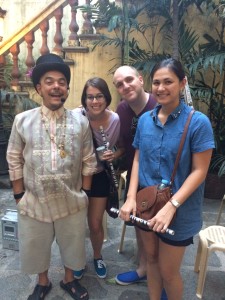Like so many who travel to a new city, I had no idea what to do first. Lucky for me, my Lonely Planet guide distilled in woman form – my girlfriend – is much better at this than me.
So off we went to discover as much about Manila as we could in 36 hours. First stop: the American War Cemetery. As a couple, we are normally big supporters of using local transport. You can understand a lot about a city by its transport (or not, if you have experienced the inverted maps in Taipei’s metro stations). However, if you are time pressed the only way to cover such great distances effectively in Manila, for the time being, is in a taxi. On reaching the cemetery you are blown away by how beautiful the grounds are and it strikes you just how important the relationship between the US and the Philippines is. This relationship becomes increasingly apparent the further you dive into Manila’s underbelly.
This underbelly led us across Malate to Chinatown.
Chinatowns come in two forms – the ones that look like the 1930s depiction of Shanghai found in most films and the Chinatowns that are living and breathing communities. The Manila Chinatown falls into the latter. Of course, this meant that there was little of spectacle to entertain but nonetheless a worthwhile venture just to understand the part Chinese migrants played in Philippines.
Next up was the beating heart of Manila’s past. Intramuros.
Intramuros is a gateway to understanding the Catholic and Spanish influence of the past. The walled-city houses Fort Santiago where the shrine of their national hero, Jose Rizal, is kept, the remaining Manila cathedral, and streets upon streets of buildings that offers just a small insight into the Philippines past. All my preconceptions were swept away with the fantastic tour hosted by Carlos Celdran. Part performance artist, part comedian, and absolutely the history teacher you wished you had at school. Carlos gave us, and about 70 others, a tour that threw open our understanding of Spanish colonialism, Catholic rule, and the part America played into turning the ‘Pearl of the Orient’ into a place very much confused by its own identity.
With his performance still vividly in mind we decided to watch the sunset and drink in some surroundings of a city whose charm very much creeps up on you. Obviously not all travel needs to be conducted on the back of a bike, and sometimes paying a little extra brings its benefits. So head to the Bayleaf Hotel, grab a glass of wine and watch the sun set over the sea whilst enjoying a complete view of some of the very best of Manila.
Finally, our day ended with a few drinks. The main reason to go for drinks anywhere in Manila, in my opinion, is so that you can drink the excellent rum, Don Papa. I really would advise anyone who has a taste for rum, or any spirit for that matter, to take some time out to try.
The next day we had a little time to head over to Rizal Park, where the national hero is buried. If you have more time than we had, fitting in the park just after Intramuros is easy to do as they are almost next to each other.
So that was it. When I left Manila I suddenly realized why I had such sporadic knowledge of the place. It’s simply because as a city, and as a country, it is still trying to work out what it is today. This makes it a truly difficult place to know and a truly fascinating place to discover.







